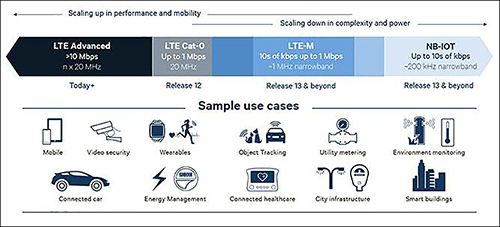Sep 09, 2016This summer, the 3rd Generation Partnership Project (3GPP), a consortium of telecommunications standards bodies, decided to standardize Narrow-Band Long-Term Evolution (NB-LTE) technology (also referred to as NB-IoT or Cat-NB1), which is a variant of LTE cellular technology optimized to meet the performance requirements of Internet of Things nodes. The term "narrow band" refers to the use of a small slice of the cellular radio spectrum to transmit short packets of data to and from a large number of devices deployed across a wide area.
Cat-NB1 supports data rates of up to 10 kilobits per second using 200 kHz of spectrum, leveraging existing cellular network infrastructure. The specification was developed with an eye toward supporting IoT devices that do not need to send much data, nor often, but do require a long battery life. 3GPP also developed another specification specifically to support IoT applications, but those with slightly greater data-transmission needs. Known as Cat-M1, that spec supports data rates of up to 1 megabyte per second using 1.4 MHz of spectrum.
These two standards represent the cellular industry's effort to capture IoT-related business and compete for marketshare against companies that are building low-power wide-area networks (LPWAN) for the IoT, which operate across non-licensed spectrum, using proprietary, non-cellular technology—such as Sigfox, Ingenu's Random Phase Multiple Access (RPMA) and LoRa (a specification to which a consortium of companies, the LoRa Alliance, are making compliant products). And while the cellular industry is targeting mostly commercial applications—from agriculture to oil and gas to smart-city deployments (smart meters and so forth)—with the Cat-M1's higher payload, the industry also sees likely applications in wearables, such as smart watches, which could be used for days or weeks before requiring a recharge.
During the days leading up to this week's U.S. cellular industry event, CTIA Super Mobility 2016, in Las Vegas, and at the event itself, it had become clear that chipmakers and carriers are vying hard to leverage these new specifications to get a share of the IoT pie.
• Verizon said it plans to deploy a Cat-M1 network by early next year, and that it is partnering with Qualcomm to integrate Verizon's ThingSpace IoT platform into Qualcomm's new MDM9206 Cat-M1 modem to reduce the cost and complexity of launching an IoT device on the carrier's network. In a statement, Rosemary McNally, Verizon's VP of mobile devices and OS technology, said the company is "taking direct aim at" LPWANs with its Cat-M1 network.
• French chipmaker Sequans demonstrated its Monarch dual LTE Cat-M1/Cat-NB1 chip at the event, communicating with a base station emulator.
• Telit, a company that makes IoT modules, unveiled its plans to introduce five discrete modules: four Cat-M1 modules operating unnamed U.S. carrier networks and one Cat-NB1 module for the European market. It said the modules will be available in small quantities later this year, with commercial availability slated for early 2017.
• Another IoT module manufacturer, u-blox, announced plans to launch a Cat-M1 module, dubbed SARA-R4, during the fourth quarter of this year. But it also announced a partnership with Ingenu in which u-blox will develop and manufacture products supporting Ingenu's RPMA technology, which employs a proprietary RF modulation scheme and transmits data via the 2.4 GHz band. These products are also expected to be available during the fourth quarter.
• Sierra Wireless, a manufacturer of embedded electronics and gateways, announced that it will launch a pilot with AT&T in November in San Francisco, the purpose of which will be to evaluate Sierra Wireless's new Cat-M1 module, called AirPrime. The companies did not reveal any details about the pilot, however.
• Senet, a New Hampshire company that is deploying a public LoRa-based LPWAN across the United States, announced this week that it has partnered with digital security provider Gemalto, whose Trusted Key Manager service allows end users to provision and authenticate keys in order to secure data that they transmit across Senet's network.
If these types of rollouts keep coming, it seems likely that by this time next year, end users of IoT technology will have more connectivity options and products to choose from.

